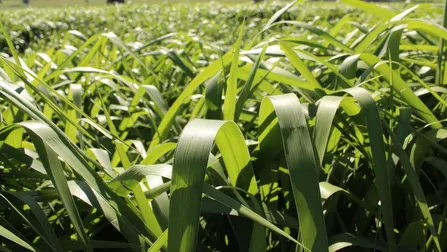Indicação
Devido a sua excelente qualidade nutricional, palatabilidade e porte médio, possui uma ampla aptidão para diversas categorias e espécies animais, sendo recomendada para todas as fases da produção de leite e carne, além de equinos, caprinos e ovinos. É indicada para solos de alta fertilidade, corrigidos e adubados, no sistema intensivo de pastejo rotacionado. Possui folhas e talos finos, o que permite produzir feno e silagem de excelente qualidade. Tem boa adaptação ao clima subtropical.
Megathyrsus maximus cv. MG18 Áries II
Panicum maximum cv. MG18 Áries II
Certificado n° 20190248 em 14/05/2019
Alta fertilidade
Para pastejo direto, feno e silagem
18 a 20 t/ha/ano de matéria seca (M.S.)
10 a 15%
0,60 a 1,00m
62 a 66%
Excelente
Muito boa
Muito boa
Perene
Características Agronômicas
Exigente em fertilidade do solo, boa tolerância às condições climáticas subtropicais. Intenso perfilhamento basal, folhas e talos finos, excelente qualidade nutricional.
Utilização e Manejo
O cultivar MG18 Áries II, devido a sua excelente digestibilidade (62 a 66% “in vitro”) e qualidade nutricional (10 a 15% de P.B.) é recomendado para animais altamente seletivos e exigentes como: equinos, ovinos e caprinos, além de toda a cadeia de produção de leite e de carne. Possui capacidade de produção de 20t a 30t/ha/ano de matéria seca. Recomenda-se utilizar em pastejo rotacionado, com manejo de entrada dos animais com as plantas em torno de 60 cm de altura e retirá-los quando atingir 30cm do solo. É recomendada também para silagem ou fenação.
Origem
O cultivar híbrido MG18 Áries II foi obtido de cruzamento artificial, realizado no ano de 2012, em casa-de-vegetação pela Matsuda, cruzando um acesso sexual denominado SPM-92 (fêmea) com Áries (polinizador). Os acessos utilizados nos cruzamentos são do Banco Ativo de Germoplasma da Matsuda. Nos anos seguintes houve novos cruzamentos, retrocruzamentos e seleção de genótipos superiores. Selecionou-se progênies segregantes para apomoxia e sexualidade. As progênies sexuais foram eliminadas e a seleção massal ocorreu nas progênies apomíticas. Os testes de DHE (Distinguibilidade, Homogeneidade e Estabilidade) e os ensaios de VCU (Valor, Cultivo e Uso) de corte e de pastejo, ocorreram em Álvares Machado-SP e em Mirante do Paranapanema-SP. Ensaios de adaptação ao clima frio foram realizados na região de Quaraí-RS.
Características Morfológicas
É uma gramínea cespitosa de crescimento mais prostrado (comparada ao Áries) de ciclo perene, com altura entre 0,6 a 1,0m (planta de porte baixo), grande quantidade de perfilhos basais e axilares, colmo fino, comprimento do internódio curto, colmo com pouca cerosidade, folha com pilosidade média na bainha, comprimento da lâmina curto e estreito, de crescimento arqueado e de coloração verde clara. O período de florescimento é indefinido e seu ciclo é precoce, fazendo com que a planta floresça diversas vezes ao ano. Este florescimento indeterminado permite a planta manter suas qualidades nutricionais mesmo no florescimento.






